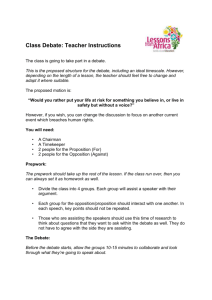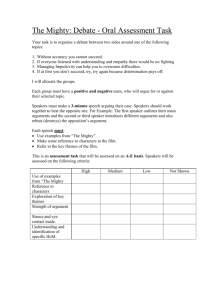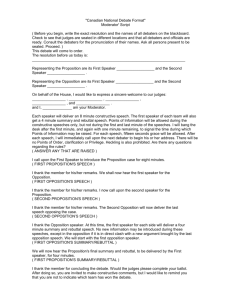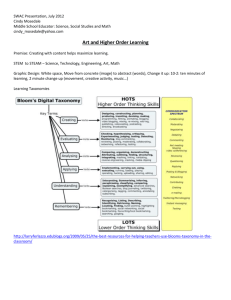debate assessment - Hwa Chong Institution
advertisement
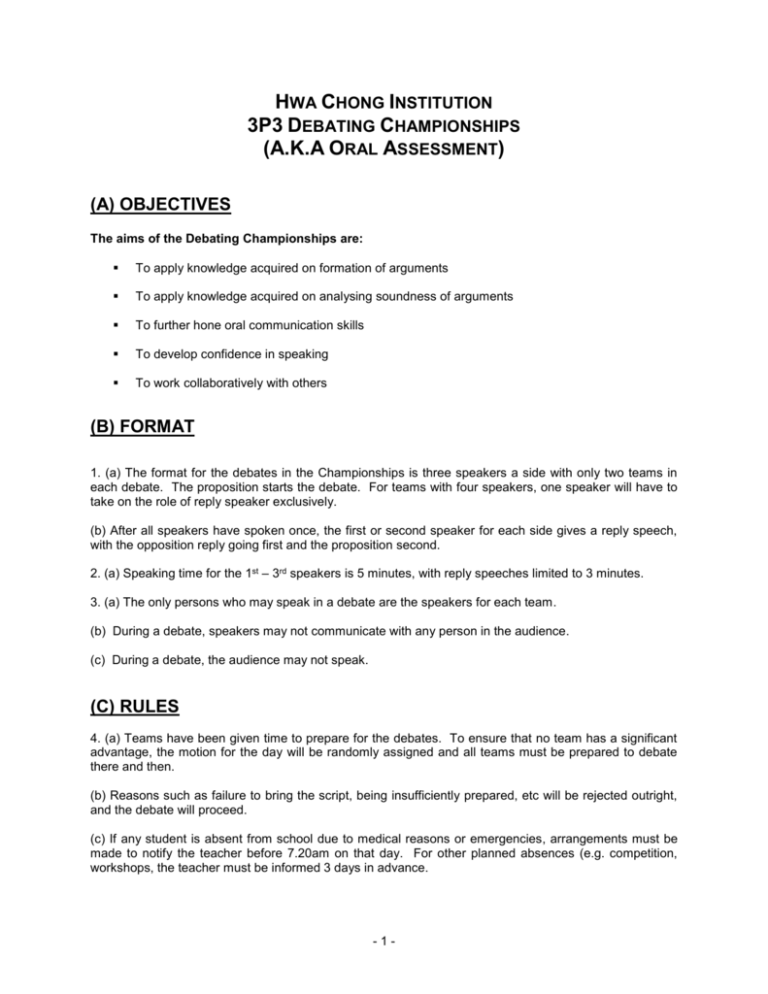
HWA CHONG INSTITUTION 3P3 DEBATING CHAMPIONSHIPS (A.K.A ORAL ASSESSMENT) (A) OBJECTIVES The aims of the Debating Championships are: To apply knowledge acquired on formation of arguments To apply knowledge acquired on analysing soundness of arguments To further hone oral communication skills To develop confidence in speaking To work collaboratively with others (B) FORMAT 1. (a) The format for the debates in the Championships is three speakers a side with only two teams in each debate. The proposition starts the debate. For teams with four speakers, one speaker will have to take on the role of reply speaker exclusively. (b) After all speakers have spoken once, the first or second speaker for each side gives a reply speech, with the opposition reply going first and the proposition second. 2. (a) Speaking time for the 1st – 3rd speakers is 5 minutes, with reply speeches limited to 3 minutes. 3. (a) The only persons who may speak in a debate are the speakers for each team. (b) During a debate, speakers may not communicate with any person in the audience. (c) During a debate, the audience may not speak. (C) RULES 4. (a) Teams have been given time to prepare for the debates. To ensure that no team has a significant advantage, the motion for the day will be randomly assigned and all teams must be prepared to debate there and then. (b) Reasons such as failure to bring the script, being insufficiently prepared, etc will be rejected outright, and the debate will proceed. (c) If any student is absent from school due to medical reasons or emergencies, arrangements must be made to notify the teacher before 7.20am on that day. For other planned absences (e.g. competition, workshops, the teacher must be informed 3 days in advance. -1- (d) If a student misses a debate without providing prior notice or a valid reason, no replacement debates will be arranged. The student will score a zero for his oral assessment. (D) DEFINITIONS AND CASES 5.1 The Proposition must present a reasonable definition of the motion. This means: 5.1.1 On receiving a motion, both teams should ask: ‘What is the issue that the two teams are expected to debate? What would an ordinary intelligent person reading the motion think that it is about?’ 5.1.2 If the motion poses a clear issue for debate (i.e. it has an obvious meaning), the Proposition must define the motion accordingly. When the motion has an obvious meaning (one which the ordinary intelligent person would realise), any other definition would not be reasonable. 5.1.3 If there is no obvious meaning to the motion, the range of possible meanings is limited to those that allow for a reasonable debate. Choosing a meaning that does not allow the Opposition room for debate would not be a reasonable definition. Truisms and tautologies leave the Opposition no room for debate and are clearly illegitimate. 5.1.4 When defining the words in the motion so as (i) to allow the obvious meaning to be debated or (ii) (when there is no obvious meaning) to give effect to a possible meaning which would allow for a reasonable debate, the Proposition must ensure that the definition is one the ordinary intelligent person would accept. 5.2 Motions expressed as general principles must be proven true as general principles. A single example will neither prove nor disprove a general principle. Finding arguments that explain the majority of relevant examples will be more important. 5.3 If the Proposition’s definition is unreasonable, the Opposition may: 5.3.1 Accept it anyway (and debate the Proposition’s case regardless); 5.3.2 Challenge it (argue that the definition is unreasonable, put up an alternative, reasonable definition and a case based on this); 5.3.3 Challenge the definition (as in 5.5.2), but argue that ‘even if’ it is reasonable, the Proposition’s case is flawed (as in 5.5.1). 5.4 The definition settled, each team has to present a case, supported by arguments and examples. 5.6.1 A case sums up the team’s arguments and states why its side of the motion is correct. 5.6.2 Arguments are reasons or rationales why the team’s case is correct. 5.6.3 Examples are facts, events, occurrences and the like that show the team’s arguments are correct. -2- (E) ROLES OF THE SPEAKERS 6.1 The role of the first speaker of the proposition is to define the topic, establish the issues for the debate, outline the proposition case, announce the case division between the speakers, and present his or her part of the proposition case. 6.2 The proposition may define the topic in any way provided that the definition 6.2.1 is reasonably close to the plain meaning of the topic, 6.2.2 allows the opposition team reasonable room to debate, 6.2.3 is not tautological, and 6.2.4 is otherwise a reasonable definition. 7.1 The role of the first speaker of the opposition side is to challenge the definition if necessary, present an alternative definition if the definition is challenged, respond to the proposition case, outline the opposition case, announce the case division, and present his or her part of the opposition case. 7.2 If the first opposition does not challenge the definition, the opposition is taken to have accepted the definition and the opposition may not challenge the definition in any other speech unless the proposition significantly alters the definition in their subsequent speeches. 8.1 The role of the second speaker of the proposition is to deal with the definition if it has been challenged, respond to the opposition case, and continue with the proposition case as outlined by the first speaker. 8.2 If the second proposition does not challenge a re-definition of the debate made by the first opposition, the proposition is taken to have accepted the opposition's re-definition and no further challenges to the definition may be made. 8.3 The role of the second speaker of the opposition is to deal with the definition if it is still in issue, respond to the proposition case, and continue with the opposition case as outlined by the first speaker. 9.1 The role of both third speakers is to deal with the definition if it is still in issue, and respond to the other team's case. 9.2 The third speaker of either team may have a small part of the team's case to present, but his is not obligatory as the third speaker's primary role is to respond to what has gone before in the debate. 9.3 If the third speaker is to present a part of the team's case, this must be announced in the case division by the first speaker. 10.1 The more the debate progresses, the more each speaker must spend time dealing with what has been said by previous speakers. 10.2 Hence the more the debate progresses, the less time will be spent by each speaker in presenting a new part of the team case and the more time will be spent responding to the other team's arguments. 11.1 The role of the reply speeches is to sum up the debate from the team's viewpoint, including a response to the other team's overall case and a summary of the speaker's own team’s case. -3- 11.2 The reply speaker may be either the first or second speaker of the team, but not the third. 11.3 The reply speakers are in reverse order, with the opposition reply first and the proposition reply last. 11.4 Neither reply speaker may introduce a new part of the team case. 11.5 A reply speaker may respond to an existing argument by raising a new example that illustrates that argument, but may not otherwise introduce a new argument. (F) POINTS OF INFORMATION 12.1 Between 1:00 and 4:00 of a speaker's substantive speech, members of the other team may offer points of information. 12.2 The purpose of a point of information is to make a short point or ask a short question of the speaker. 12.3 A point of information should be brief, and no longer than 10 seconds. 12.4 Points of information are an important part of the clash between the teams, and enable speakers to remain a part of the debate even when they are not making a speech. 12.5 The speaker has the absolute right to refuse to accept a point of information, or to accept it only at the end of the next sentence. 12.6 However, a speaker is obliged to accept some points of information, provided that they have been offered at reasonable times in the speaker's speech. 12.7 As a general rule a speaker should accept 1 or 2 points of information in his speech. A speaker who accepts a significantly greater number of points of information risks losing control of his speech. 12.8 Members of the opposing team should not offer an excessive number of points of information to the point that they are barracking. As a general rule each team member should offer no more than 2 points of information per speech, and should not offer them within a short time of a previous point of information having been offered. -4- Annex One - The Marking Standard 1. Substantive and Reply Speeches (out of 100) Standard Overall (/100) Style (/40) Content (/40) Strategy (/20) 80 32 32 16 Excellent 76-79 31 31 15-16 Extremely Good 74-75 30 30 15 Very Good 71-73 29 29 14-15 70 28 28 14 Satisfactory 67-69 27 27 13-14 Competent 65-66 26 26 13 Pass 61-64 25 25 12-13 60 24 24 12 Exceptional Good Improvement Needed -5-

